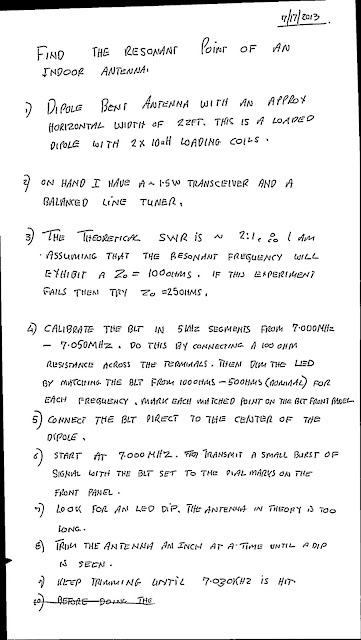During our stay in our home QTH of Morrisville, NC (near Raleigh NC) where we are enjoying time with the kids,we camped out in our home for a few days. Of course I had to get on the air.
My challenge was the fact that I had access to only a limited amount of gear. I had a Sprint ATS III. This is a 2Watt transceiver built into an altoids tin and optimized for the Spartan Sprint. I remember winning 3rd place in this contest with this rig. This rig is all SMT and gave me excellent SMT soldering practice back a few years ago. This kit was built by Steve Weber KD1JV
http://kd1jv.qrpradio.com, check out Steve's website. The rig has all the bells and whistles and is fully microprocessor controlled.
I also had a QRP Balanced Line Tuner (BLT) from Doug Hendrick's QRP kits
http://www.qrpkits.com.
Since I had my desk in a bedroom on the 2nd floor looking out to our beautiful garden it made sense for me to consider a 40m end-fed halfwave wire. In the garden there is an extremely high pine tree with a branch up at about 55ft agl. I could construct an inverted L type wire with the end terminated at the bedroom window.
I had, on hand, a T68-2 toroid core, some magnet wire, a 100 pf trimmer capacitor, a piece of scrap PC board, a short piece of RG174 and a 7 foot piece of 300 ohm ladder line. I didn't have a separate SWR meter or any way to measure SWR other than the built-in SWR meter that is integrated into the BLT. This LED SWR indicator is the one developed by Dan Tayloe N7VE.
I had a plan. The half wave wire would connect to a parallel tuned circuit. I could then link to the circuit with a balanced link coil wound to match to the 300 ohm ladder line. The ladder line would then connect the BLT sitting on my desk to the tuned circuit. Based on my previous experience I would need a 6ft 6inch counterpoise wire strung along the bedroom floor.
I assumed that the more inductance I could get from the toroid the better, since this would assist in improving mutual coupling efficiency. I am not sure if this thinking is correct? The greater turns would also reduce the Q of the resonator. A number of factors to consider here. (I really need to do some experiments in this area to better understand it). I calculated that 30 turns would result in a need for 99pf of capacitance in order to resonate the parallel circuit within the 40 m CW band at 7.030KHz. I had a 100pf trimmer. I had a plan that would work in theory at least.
The solution came together as follows. I built the resonator on the scrap piece of PCB and taped it to the window sill. A counterpoise was run along the wall and taped in place. Using my slingshot I was able to deploy the half wave wire from a branch about 55ft in the air. I then connected the resonator to the BLT via the 300 ohm ladder line.
The following procedure was used to align the system. I first connected 3x100 ohm series connected 1/4 Watt resistors to the output of the BLT. I then quickly tuned the BLT to indicate an SWR of 1:1 as indicated by the LED being extinguished. Yes the resistors did get hot! One very good feature of the Dan Tayloe circuit is the fact that it terminates the transmitter in a 50 Ohm load when in the 'Tune' position. I then moved the 300 ohm load to the far end of the 300 ohm ladderline and confirmed a 1:1 match. I now connected the ladder line directly to the coupler and was able to obtain a 1:1 match directly into the antenna system. I was pleased to see that the trimmer was almost fully meshed which lined up with my calculations.
We were only in our house for a short time but I did manage to make a number of good QSO's including one DX QSO with F6FTI om Pierre near Abbeville France around midnight. Pierre gave me a 549 report. Great! I also QSOed with K5TF, AA1PL, WA4SQQ, W8RT & KC2QKU.
It would have been interesting to experiment with different settings of the BLT and the coupler. I wanted to see if I could connect the BLT (which is a Z match) directly to the halfwave. This would require that one side of the balanced input be connected to the counterpoise.



